Sol Summary – December 3rd
Sol: 6
Summary Title: Stretching our Legs
Author’s name: Matt Eby
Mission Status: In-Simulation
Sol Activity Summary: EVA excursions to the Northern quadrants in search of diverse soil samples and to map the radiation environment.
Look Ahead Plan: Second drone flight, deploy HAM radio antenna.
Anomalies in work: EVA suit batteries.
Weather: Calm winds throughout. Early overcast skies slow to clear, largely clear by mid-afternoon with moderate temperatures.
Crew Physical Status: Crew is in good shape, nothing of concern to note.
EVA: EVA #1 led by the Commander, with XO and Crew Engineer, traveled to the special interest region. 2 1/2 hour duration using Spirit and Opportunity rovers EVA #2 led by the Health and Safety Officer, with support from the GreenHab Officer, traveled to an area flagged by EVA#1 for follow-up sampling. 2 hour duration using Curiosity rover.
Reports to be filed: Journalist, Commander, Operations, Photos, EVA report, EVA request, GreenHab
Support Requested: N/A
EVA Report – December 3rd
EVA #7
Author: Kristine Ferrone (CDR)
Purpose of EVA: Test EVA sampling tools (radiation sensor, rake, scoop, sample bags). Identify other potential areas for tools testing along return route for EVA #8 crew to explore in the afternoon.
Start Time: 09:01 AM MT
End Time: 11:39 AM MT
Narrative: CDR (Kristine Ferrone), XO (Alli Taylor), and ENG (Ashley Kowalski) left the airlock at 09:00 AM MT. Crew proceeded in rovers (CDR and XO on Oppy and ENG on Spirit) from the Hab to Cow Dung Rd, then north on Cow Dung Rd to the Special Region. Crew exited the rovers and proceeded on foot to explore the Special Region around the quarry area. Crew collected regolith samples at three diverse locations around the Special Region, including gray, red, and green soils, paying attention to the restrictions to not disturb any fossils in the area. The regolith samples were collected using a set of EVA tools developed by XO including a rake and scoop, battery-powered sifter, and special regolith sample collection bags. Crew also noted that the Special Region would be an excellent site for a drone flight later in the mission. CDR also collected radiation dose information along the route. Comms with IVA support were limited during the EVA. Crew then returned to the rovers and proceeded back to the Hab, stopping to flag a location for the EVA #8 crew to explore for further regolith sampling in the afternoon. Rovers were parked back near the Hab and were not plugged in following power status consultation with Tier 1 support.
Coordinates (use UTM WGS 84): 4256000, 518300
Participants: CDR (Kristine Ferrone), XO (Alli Taylor), and ENG (Ashley Kowalski)
Road(s) and routes per MDRS Map: Cow Dung Rd (0110) to Special Region
Mode of Travel: Rovers (Spirit and Oppy), Walking
EVA #: 8
Author: Kristine Ferrone (CDR)
Purpose of EVA: Scout sample locations and test EVA sampling tools (radiation sensor, rake, scoop, sample bags) at and around location flagged by EVA #7 crew.
Start Time: 1:00 PM MT
End Time: 2:53 PM MT
Narrative: HSO (Barbara Braun) and Green Hab Officer (Matt Eby) exited the airlock at 1:00 PM MT and proceeded in rover (Curi) from the Hab to Cow Dung Rd, then north along Cow Dung Rd to location flagged by EVA #7 crew at the “ROUTE” marker near the intersection of Brahe Hwy (1572). Crew collected regolith samples there and in an additional location West & South of the marker that they reached on foot. HSO also collected radiation dose information along the route. Crew identified additional areas for drone flight near the second collection site. Comms with IVA support were limited during the EVA, but EVA crew demonstrated simple contingency text comms using pre-canned messages triggered by a handheld communication device, which were successful. Crew then returned to the rover and proceeded back to the Hab. Rover was parked back near the Hab and was not plugged in.
Coordinates (use UTM WGS 84): 454800, 517800
Participants: HSO (Barbara Braun), Green Hab Officer (Matt Eby)
Road(s) and routes per MDRS Map: Cow Dung Rd (0110)
Mode of Travel: Rover (Curi), Walking
Commander Report – December 3rd
Sol: 6
Summary Title: EVAs #7 and #8
Author’s name: Dr. Kristine Ferrone, Commander
Mission Status: Nominal
Commander’s Report:
Crew 269 experienced another day of beautiful weather on Mars with mostly mild temperatures, sunny skies, and light high-altitude clouds. The crew enjoyed a breakfast of homemade sourdough bread, cereal, oatmeal, dried fruit, and espresso. After a morning planning meeting, HSO collected crew health stats. CDR, XO, and Engineer conducted the morning EVA #7 to the Special Region and used an EVA tool suite (rake, scoop, special sample bags) to collect regolith samples, being careful to adhere to the restrictions at the site to not disturb any fossils. CDR also collected GPS-tagged radiation dose rate measurements using a handheld dosimeter. The crew noted that this region would be an excellent site to fly the drone on a future Sol. During their return from the Special Region, EVA #7 crew marked a second site for a sample location on Cow Dung Rd. for the EVA #8 crew to return in the afternoon. After a quick lunch, HSO and Green Hab Officer conducted EVA #8 to the site on Cow Dung Rd. marked by the EVA #7 crew, where they collected further regolith samples, and HSO collected further radiation dose measurements with the handheld dosimeter. During the EVA, Technology Officer sent data to Aerospace mission support and received feedback on previously uploaded data. In the afternoon, CDR and Engineer inspected the 2-piece EVA suits. Further information can be found in today’s operations report. Before dinner, the crew completed their montage painting and assembled their inputs for the mid-mission research report. For dinner, the crew enjoyed chicken pot pie.
Operations Report – December 3rd
SOL: 6
Name of person filing report: Ashley Kowalski
Non-nominal systems: N/A
Notes on non-nominal systems: N/A
ROVERS
Spirit rover used: Yes
Hours: 202.0 (Start), 203.2 (End)
Beginning charge: 100%
Ending charge: 53%
Currently charging: No
Opportunity rover used: Yes
Hours: 106.2 (Start), 107.3 (End)
Beginning charge: 100%
Ending charge: 50%
Currently charging: No
Curiosity rover used: Yes
Hours: 214.5 (Start), 215.3 (End)
Beginning charge: 100%
Ending charge: 54%
Currently charging: No
Perseverance rover used: No
Hours: N/A
Beginning charge: N/A
Ending charge: N/A
Currently charging: N/A
General notes on rovers: No additional notes/comments.
Summary of Hab operations:
WATER USE: 175 gallons remaining (375 gallons used)
Water (static tank): A “Supplemental Operations Report” was received by the crew today from Dr. Shannon Rupert. She informed us that our water tank is at 175 gallons, and that a water resupply vessel will arrive tomorrow to add water to the tank.
Static tank pipe heater (on or off): On
Static tank heater (On or off): On
Toilet tank emptied: Yes. The tank was emptied this morning at ~7:45 AM.
Summary of internet: No issues with the internet. Connection is good.
Summary of suits and radios:
The Crew Engineer and Commander inspected all six of the two-piece EVA suits today by opening the backpacks and checking the battery voltage with the multimeter. Three of the six suits were reading a voltage much lower that ~12 V despite being plugged in properly (switch was in the “off” position) and charging all night.
Thus, we believe that the three two-piece suits reading low voltages need new batteries. Please advise if you would like the Crew Engineer to locate and replace the batteries on EVA Suits #3, #4, and #6.
Furthermore, we decided to test out the performance of one of the functional suits to ensure that it could withstand a three-hour EVA. To that end, we turned on EVA Suit #2 at 3:28 PM and let it run for three hours. The suit remained functional for the full three-hour time block. Thus, we can confidently conclude that EVA Suits #1, #2, and #5, the suits which had > 12 V readings, are suitable for EVA use.
Finally, the two walkie talkies mentioned previous reports (one from the upstairs set and one from the downstairs set) are still not working.
Summary of GreenHab operations: Additional information can be found in the GreenHab Report.
WATER USE: ~31 gallons (~3 gallons today)
Heater: On
Supplemental light: In the “Supplemental Operations Report” we received today from Dr. Shannon Rupert, she said that the supplemental lighting will now be activated from 10 PM to 2 AM. We will inform Mission Support if we notice the supplemental light on at any other times.
Harvest: N/A
Summary of ScienceDome operations: No operations performed today by the crew in the Science Dome.
Dual split: In the “Supplemental Operations Report” we received today from Dr. Shannon Rupert, she said that she is turning on the heat in the Science Dome beginning today. We acknowledge the note to not adjust the settings in any way.
Summary of RAM operations: N/A
Summary of any observatory issues: No observatory issues.
Summary of health and safety issues: No health and safety issues.
Questions, concerns and requests to Mission Support: There is a lingering odor coming from the bathroom. The Crew Engineer, with the assistance of the GreenHab Officer, emptied the tank at ~7:45 AM this morning, yet the odor is still present ~11 hours later. The handbook mentions that we should consult with Mission Support if this is the case. Please advise us on how to improve this odor situation. We look forward to receiving your suggestions.
Research Report – December 3rd
[category science-report]
Crew 269 Mid-Mission Research Report
Mid-Mission Research Report
Crew 269 – The Aerospace Corporation Crew
27 Nov – 10 Dec 2022
Commander: Dr. Kristine Ferrone
Executive Officer: Allison Taylor
Health and Safety Officer: Barbara Braun
Green Hab Officer : Matthew Eby
Engineer: Ashley Kowalski
Technology Officer: Trevor Jahn
I. EVA Planning (A. Taylor)
Crew 269 completed on-site training, configured experiments, and prepared equipment prior to simulation start. The crew has been adaptive to EVA planning needs, requirements, site constraints, and other challenges such as windy conditions impacting launch decisions for the drone. The original EVA plan provides a template for mission objectives, and color-coded blocks allow for shifting and replanning daily prior to submitting the EVA requests to MDRS mission support. Our look ahead plan for EVAs includes another mirror payload retrieval, inspection, and redeployment, along with additional photogrammetry with drone, augmented reality demonstrations, tools testing at additional sites of interest, ham radio antenna deployment, and high-altitude weather balloon deployment.
II. Project Phantom Virtual Reality/Augmented Reality Demonstration (T. Jahn)
The primary objectives of this activity are to demonstrate using various photogrammetry techniques to create 3D models from data collection done by flying drones, remote control rovers, and handheld devices; demonstrate using augmented reality (AR) software for mission planning, demonstrate AR software for EVA activities, and demonstrate mission planning for using photogrammetry data. Since arriving at MDRS, I have demonstrated using various photogrammetry techniques to create 3D models from data collection done by flying drones, remote control rovers, and handheld devices. Timelapse photos have been collected multiple times from remote control rovers, and the first drone flight to collect timelapse photos has been completed with more planned for next week. Timelapse photos have been sent to The Aerospace Corporation mission support team, and they have been processing them to produce the best outcome for at least a few days. I also demonstrated using virtual reality hardware software for mission planning; at least one EVA was planned using virtual reality and 3D mapping from satellite imaging. I’ve also demonstrated augmented reality software on multiple EVAs and continue to work in conjunction with Aerospace mission support to improve it for the remainder of the mission. I’ve also demonstrated mission planning using photogrammetry data. Data has been uploaded to the Aerospace mission support team for processing to be used in mission planning during the second week of the mission, and I’ve received the first 3D models from the Aerospace mission support team with more expected early next week.
III. Mirror Coating Experiment (A. Kowalski)
Highly reflective silver mirrors are used in many space applications, but exposure to environmental contaminants can rapidly degrade optical performance. The primary objective of this experiment is to monitor and characterize mirror surface degradation under a simulated, accelerated environmental exposure over the two-week period we are here at MDRS. To fulfill this objective, we deployed four different mirror samples close to Marble Ritual on Sol 1. On Sol 5, I inspected the mirror samples in the Science Dome under the Aerospace Corporation microscope, noted the locations of abnormalities on the mirrors, and saved images of those areas. Upon completion of this inspection, we redeployed the mirror samples to the Martian environment on the same day. I will perform two more mirror sample retrievals, inspections, and redeployments during the remaining time at MDRS.
IV. EVA Tools Demonstration and Regolith Sample Collection (A. Taylor)
The main goal of demonstrating the EVA tools is to evaluate the operational use of the selected commercial-off-the-shelf (COTS) tools in accomplishing regolith sampling during planetary surface EVAs. The tools include a rake and scoop, handheld battery-powered sifter with 75-micron mesh, and special sample collection bags. Since arriving at MDRS, the crew has successfully collected six regolith samples from sites near the Hab, the Special Region in the Valles Marineris quadrant, and other sites of interest along known traverse routes. The tools are performing and holding up well, and photographs for each collection site have been taken. The sifted regolith is the first step in the beneficiation of material for in situ resource utilization (ISRU) processing, as ISRU processing requires specific grain sizes. The regolith samples will be sent to a laboratory at The Aerospace Corporation for analysis to determine if any of the sampled regions near MDRS have compositions suitable for ISRU processing, such as creating building materials. We hypothesize that samples from the Moon and Mars will be analyzed for purposes such as future site construction with the goal to maximize the use of in situ material.
V. Radiation Environment Monitoring and Mapping (K. Ferrone)
The primary objective of this activity is to demonstrate the use of a handheld portable radiation dosimeter to collect GPS-tagged radiation dose rate data to create a dose rate map of a designated area on Mars or other planetary surface. Since arriving at MDRS, I have collected GPS-tagged environmental radiation dose rate measurements at regular intervals using the handheld Radex RD1212-BT radiation dosimeter. This dosimeter records the GPS-tagged dose rate in preset intervals, and that data can be used to create a radiation dose rate map. Crews could use such a map to aid in EVA planning to identify exposed or protected solar radiation areas or to locate radioisotopes on the surface. The GPS-tagged radiation dose rate data may also be integrated into VR/AR models created by Project Phantom in the future.
VI. Weather Balloon Release (M. Eby)
The main goal of the balloon experiment is to prepare and launch a high-altitude weather balloon in an analog Martian environment and space suits. The experiment will measure the dust in the atmosphere from ground level to 90,000 ft, but the use of balloons on Mars enables a range of rapid response, on-demand science and communications payloads. Since arriving at MDRS, I have tested the ground tracking station. Flight batteries will be loaded into the payload within the Hab this weekend, completing our preparation. Weather pending, launch is expected on Sol 11.
VII. Exercise and Fitness Protocols (B. Braun)
The main objective of this activity is to evaluate compact fitness equipment (provided by Hygear) and other exercise protocols for maintaining astronaut fitness in a confined habitat or space station environment. Since arriving at MDRS, 5 of 6 crew members have used the Hygear fitness bands and jump rope equipment. The fitness bands have a simple attachment mechanism consisting of webbing and a carabiner that can be adjusted to fit into several slots; this makes it ideal for use in an environment with limited fixed mounts as it can be attached to any permanent solid structure at many different heights to facilitate exercising different muscle groups. The bands also are very compact and easy to transport, and use elasticity rather than weight to provide resistance, which is appropriate for a low-gravity environment. However, the bands do require a moderate amount of space to stretch to their full length, which might be difficult to find in a station or habitat environment. Crews are finding the jump rope and rope-free weighted jump balls surprisingly effective; the weighted rope-free handles are particularly effective for confined spaces. The 15-minute workouts are quick and can be done in and around other duties, but the crew is having difficulty fitting the recommended three workouts into their day, especially given the overhead required to change, set up for a workout, and then stow gear and change back into station gear after the workout is over. Crew members are also utilizing exercise videos which allow for a nearly infinite variety in workout types and styles, but which would be less effective in a low-gravity environment. The crew will continue to evaluate the fitness protocols throughout the end of the rotation
VIII. Discord Crew Communication Demonstration (B. Braun)
The purpose of this activity is to demonstrate low-bandwidth high-latency messaging (similar to texting) as a way for crew members to keep in touch with family and mission support back “home.” The protocol is set up through a special Discord server which is limited to invited members only. The server simulates the light-time delay between Earth and Mars (currently five minutes each way) and allows only text-based messaging (no voice or video). Each crew member has private channels for talking to family and friends, and group channels for talking to principal investigators, mission support, and STEM teachers back on “earth.” The crew has used the Discord server extensively, not only to communicate with family and friends, but also answer questions from elementary school classrooms and to discuss experiment protocols with principal investigators. In one case, a crewmember used the Discord server to consult with a subject-matter expert back on earth about an anomaly in an experiment setup. The crew plans to continue to evaluate the use of Discord over the rest of the rotation to determine how effective low-bandwidth communication is at keeping crew members in touch.
IX. Ham Radio Demonstration (K. Ferrone)
The objective of this activity is to demonstrate that crews can successfully deploy a ham radio field antenna in a Mars analog environment and space suit to aid in surface navigation and communications. Since arriving at MDRS, the three ham radio operators on the crew (Ferrone, Braun, Eby) have completed activation and checkout of the MDRS ham radio station and two of our own handheld ham radios and trained on the deployment procedure for the antenna. EVA is planned for Sol 7 to deploy antenna and initiate contacts.
X. Green Hab Operations (M. Eby)
The primary objective of this activity is to gain experience in the day-to-day operations of growing and caring for plants in a simulated Mars station. Since arriving at MDRS, I have worked with plants at various stages of the growth cycle from new seedlings, to plants starting to flower, to plants ready to harvest. Edible plants supplementing the crew dinner table are tracked based on weight and date harvested.
Journalist Report – December 3rd
Sol: 6
Author: Trevor Jahn, Technology Officer
December 3, 2022, and Sol 6 on Mars, the Mars Desert Research Station Crew awoke to anticipation, as they prepared for their two furthest EVAs yet. Breakfast was a delicious combination of sourdough bread with various toppings ranging from honey, butter, olive oil, and chocolate spread, but not all at once of course. With the smell of eucalyptus coming from the humidifier the crew brought from home, the Crew Habitat filled with its sweet aroma. The crew passed health checkouts with flying colors after breakfast, and began preparation for their first EVA.
Allison Taylor, Kristine Ferrone, and Ashley Kowalski departed the Airlock at 9:01 am, and continued via crew rover along Cow Dung Road to the Special Region North of Gateway to Lith, where they would search for regolith samples, took radiation measurements, and scouted out future drone flight locations. The morning EVA crew had limited coms with IVA as they past Gateway to Condor along Cow Dung Road, and the EVA crew switched coms to channel two for local communication. IVA took the opportunity to discuss what they would do to plan a rescue in the event the EVA crew did not make contact at the end of their EVA window.
Shortly after EVA Crew 1’s arrival back inside the Crew Habitat, the afternoon EVA Crew began preparation, and exited the airlock at 1:01 pm, proceeded along Cow Dung Road, heading North in Crew Rover Curiosity. The EVA Crew consisted of Matthew Eby and Barbra Braun. They maintained communication with IVA, which was operated by Trevor Jahn, until nearly reached Galileo Road, when communication was no longer possible. IVA continued to attempt 15 min check-ins with the EVA crew, but the EVA crew was able to successfully send “all is well” communications over satellite transponder. The EVA crew made their way back to the marked location from the morning EVA, and continued to collect regolith samples as a follow up to the morning’s EVA sample collection, and collected samples at a second point of interest, before returning to the airlock at 2:53 pm.
Crew 269 was very tired after the end of their first week on mission, but continued to work on various things around the crew habitat throughout the day, and made time to drink hot coco and listen to holiday music to get in the holiday spirit as the calendar progressed into December only a few days prior. The crew bundled up in blankets in protest to the December cold night air, and the sound of busy keyboards could be heard throughout the habitat as the clock ticked closer to dinner time and as the conclusion of Sol 6 rapidly approached, the wind continued to howl across the barren cold landscape of the Martian surface, only inches beyond the thin white walls of Crew 269’s temporary home.
GreenHab Report – December 3rd
GreenHab Officer: Matthew Eby
Environmental control: Heater on, door closed, 20% humidity.
Average temperatures: 70-deg F at time of watering. Range prior 24 hours: 65-deg F – 88-deg F
Hours of supplemental light: 0 hours
Daily water usage for crops: Approximately 3 gallons
Daily water usage for research and/or other purposes: 0 gallons
Water in Blue Tank: Approximately 215 gallons (Based on a 250 gallon capacity, visually 85% full)
Time(s) of watering for crops: 4 PM
Changes to crops: None
Narrative: Today a small test planting of prior season (2021) Radish seeds were planted to test the germination rate of seeds stored for an extended duration. Also of note, a sugar snap pea sprouted, joining his neighbors, see attached picture.
Harvest: None
Support/supplies needed: None needed at this time.


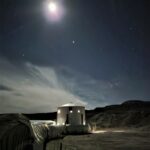
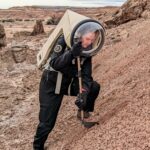
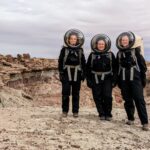

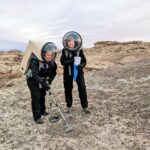
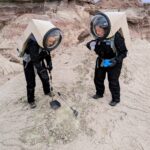
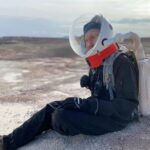
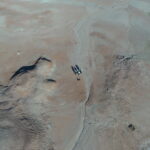
You must be logged in to post a comment.